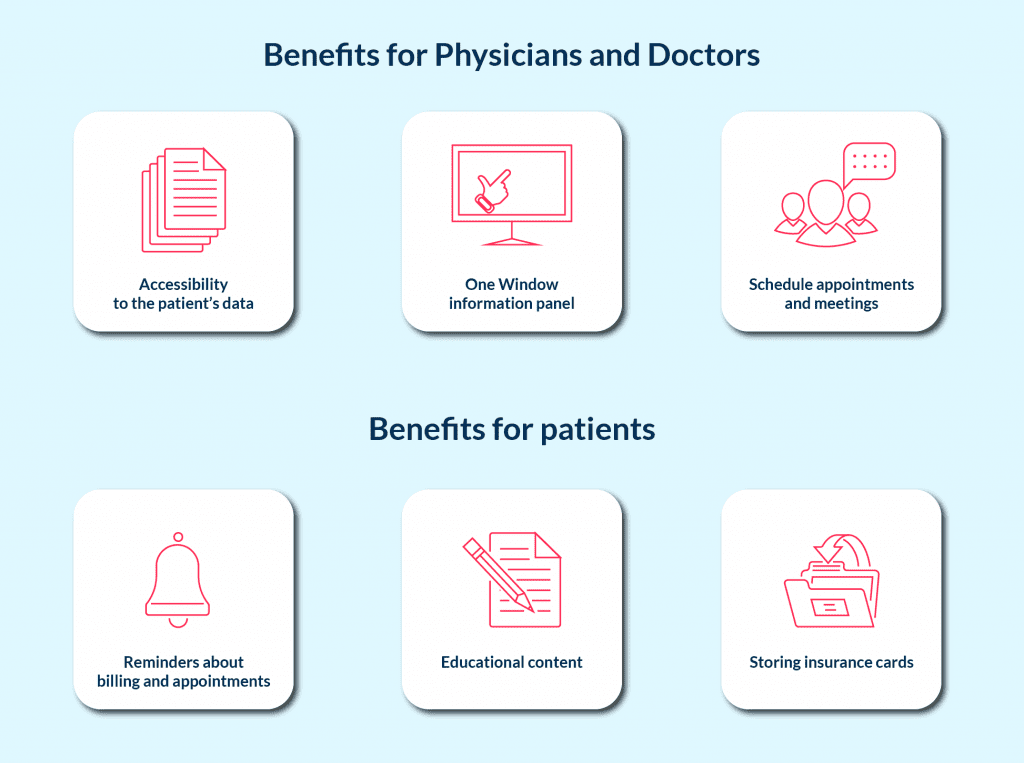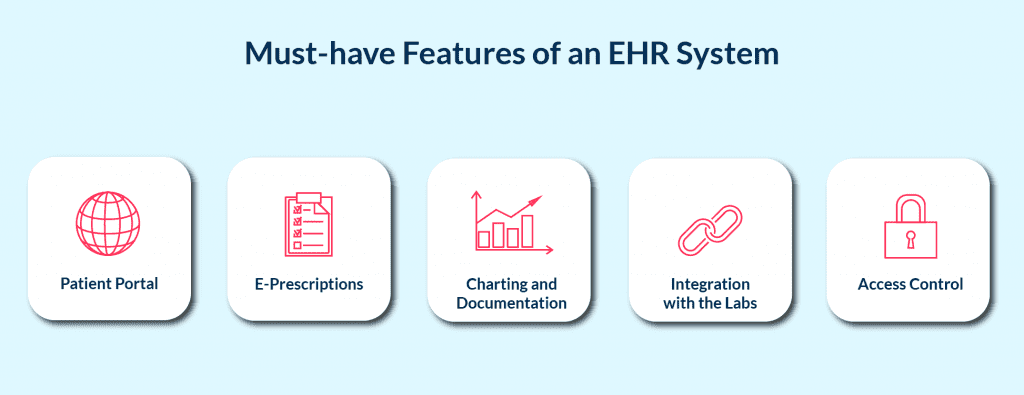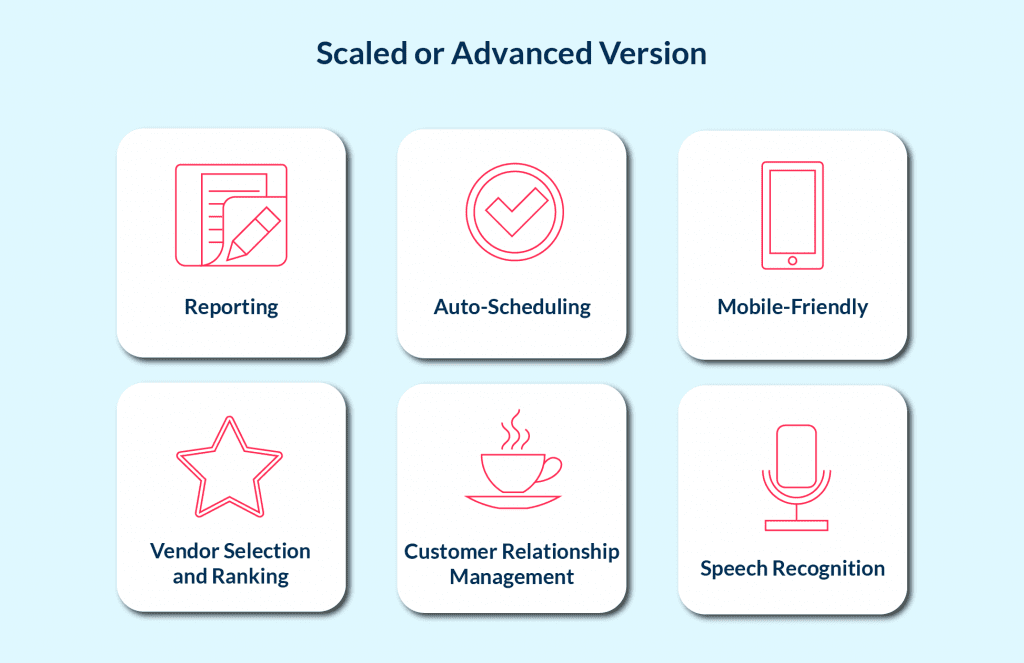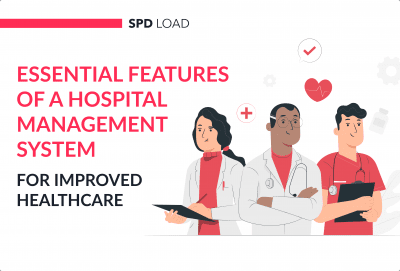EHR Software Development: A Step-by-Step Guide
- Updated: Nov 14, 2024
- 16 min
Need an electronic health record system for your practice? Building custom EHR software from scratch is a big undertaking, but worth it to get the exact features and functionality you want.
In this blog, we’ll walk you through the step-by-step process of EHR development. You’ll learn:
- Key planning steps like defining goals, features, and end users
- How to map out an efficient workflow that matches real patient visits
- Tips for crafting intuitive interfaces and data visualizations
- Strategies for testing, troubleshooting, and maintaining data security
By the end, you’ll have a roadmap to launch a custom platform tailored for modern medical practice. Let’s get started!
Curious about the impact? Here’s a look at the benefits of electronic health records for healthcare teams and patients
Unlock your startup potential now — start transforming your vision into a scalable solution with our expert developers today!
Benefits of EHR Systems
Here are a few benefits of an EHR System Development for Physicians and Doctors.
- Accessibility to the patient’s data in an easy to understand form.
- One Window information panel about the patient’s drugs, condition, and treatment.
- Helps smoothen the process of treating a patient.
- Schedule appointments and meetings.
- An EHR system helps doctors enhance their development in preventative care.
- Electronic health records EHR, allows to obtain of electronic data on patients.
Benefits of an EHR software development for patients:
- Set appointments with their doctors via an EHR system.
- The patients can receive reminders and notifications about medical billing and appointments. They will know how to take precautions and build preventive measures with the help of medical practices.
- Forwards educational content related to the disease or patient’s condition.
- Provides a portal to patients for storing insurance cards and other types of cards.

Must-Have EHR System Features
Are you looking for answers to how to create an electronic medical record system? If yes, then stay tuned. Going forward, we are discussing how to build the major features of EHR System Development.
The hospitals today want a tailor-made EHR Software and practice management system. A solution that can fulfill their unique requirements. Due to this the development process is liable to change. However, there are some core features that make up the basic structure of such a system through clinical decision support.
Along with a basic introduction to these features, let’s discover the process of creating them, along with the costs of EMR systems development.
| Patient Portal | This is a basic and yet the most important feature. Your answer to how to build an EHR system starts from identifying the must-have features. So, you should know how to create a patient portal. This is the page where all the information about a patient is accessible. It includes name, age, medical information, allergies, lab tests, medication, and everything else. Plus, the electronic medical record system’s patient portal is available to all the concerned personnel. It can be doctors, lab assistants, the patient himself. A patient’s portal on the EMR software allows the physicians to record, add, and view this data. The development of such a function is at the bottom of the whole system. So you must go including it in the MVP version too. |
| E-Prescriptions | Another good feature essential for an Electronic Medical Record System is E-Prescriptions. This is an exclusive portal that records and maintains all the prescriptions. An EHR system includes treatments, conditions, and contradictions. Knowing how to create a system with this feature in it is critical. The motive of adding this feature is increasing the visibility of the patient’s health. Also, it will help the physicians and doctors know how to build and make correct decisions. Since the information in the system is accessible. They can understand the past medical history. Along with this, there are various other advantages of having an EHR system in hospitals. |
| Charting and Documentation | EMR Software development process must include charting functionality. Doctors and physicians are never in the favor of filling out forms and charts. Record software allows them to complete these small tasks with efficiency. The development of your software should take into account a few smart aspects. Knowing how to create these smart features is profitable. Like allowing customizing the chart templates. Further, you can also add voice recognition and dictation and allow responsive charts. The EMR software must optimize as per the underlying device. If your client allows and can afford the inclusion of machine learning, go for it. This will have a great advantage. With machine learning, you can automate some processes. Like standard information, auto-filling, and checkboxes, etc. For this, you will have to know how to build an EHR System with advanced techniques. And employ an expert team of developers. |
| Integration with the Labs | In the next step while the development of the EHR System we have lab integration features. Lab integration allows doctors to track and receive test results. They will know how to go forward with the treatment. It fast tracks the whole system and builds credibility. Wherein the labs will know which tests to conduct and the doctors will get accurate results. Let’s know how to create an ideal EHR system. The key is to connect the patient’s medical history with the current procedures. This way even the lab technicians will know about the conditions. With such an electronic medical record system they can identify the markers of condition and consult with the doctors directly. |
| Access Control | When you learn how to develop EHR, compliance is essential. As per the privacy rules, everyone should not have access to the patient’s medical history. Only the concerned person can have access to it. But how to control the access. The answer is develop EHR with certain set restrictions. This means that you need to add stringent access control features. The Doctors, nurses, and other staff shall only have the required access. It is important to secure the application. Plus, this is the solution for how to create an efficient and secure portal in a hospital. These are the four features that you must know about while looking for how to create EMR Software. They provide the basic infrastructure for the software. After this, it is easier to modify the software. Diversifying from these features, you can also scale the Electronic Medical Record System. |

Innovation is the key to leadership. Here’s how to win the technology race in the healthcare industry.
EHR Software Development Tech Stack
Next up in our discussion on how to build EHR System, we will take up the technical requirements. Start with the Technology Stack applicable to the frameworks and architecture.
Technology Stack for an EHR Software
Now the question arises, how to develop such a software. Specifically, which technologies are vital for the development of EMR software. With added customizations you need an appropriate set of technologies. Hence, we are providing an ideal tech-stack for your software.
Tech Stack refers to the usage of technologies providing the answer for how to create EMR software. We use Node.JS for EHR software development.
Development Team
EHR or EMR software development team is the next part of the guide. Your dedicated development team must be able to handle custom development. They must know how to tailor a niche healthcare mobile application development. Irrespective of this fact, you need to employ the following team members to develop EHR.
- 2 Front End Developer
- 2 Back End Developers
- 1 Quality Assurance
- Project Managment+communication = 12% from all hours
- 1 UI/UX Designer – first month
- Devops – on demand role
Partner with SPDLoad to improve how you deliver patient care
Architecture of an EHR System
Architecture is the next aspect of how to create an electronic medical record system. The architecture of the EHR software development needs to be a service-oriented architecture. This type of architecture enhances interoperability.
So, how to build the software under this approach is essential. Divide the whole process into several modules.
This way, you will understand how to build software that is easier to scale and test. They are interconnected to each other with an API. The motive of this interconnectedness is to keep a buffer to scale an EHR system. This makes the software scalable. It creates an environment to identify faults and ensure maintenance.
Further, since it is a healthcare software, it must also be HIPAA or GDPR Compliant. As per the region, HIPAA compliance is essential in the USA. And GDPR compliance is essential in the European nations for development.
You will know more about how to develop HIPAA compliant EHR in the later sections.
Further, the software architecture includes the basic navigability of the EHR System. For instance, how the patient or the doctor will operate it.
Front End Development
The next question is how to create EMR software that is intuitive and effective. The answer is triumphing its front end development. For Front End EMR Software development we can use one of three languages. This includes Javascript, or HTML5, or CSS3. We design the software as per the requirements of the client.
The motive must be to create a smooth and sleek design. Such a design stands out of the other similar healthcare EHR software. The designers need to know how to develop an eye-catchy and intuitive interface.
Back End Development
Under this, the developers will create the database layer. This process builds the basic structure of the EHR software development. Where the developers use Laravel to build the software frameworks. They use MySQL to build the EMR software database.
If you’re working with Laravel, these best Laravel tools and resources will streamline your workflow.
Wondering where to look for Laravel developers? Learn the step-by-step process in this guide on how to find a Laravel developer.
After dividing all these tasks into different modules, the development work begins. In the end, all the modules come together to work in unison as a single software.
Cost of EHR System Development
How much will it cost to create an EMR software? One of the biggest concerns to develop EHR is the cost. In the next section on how to build an EHR system, we will compare the costs.
The MVP development process of the EHR platform includes those features which are essential. Or, we can also say that they are mandatory and help build a foundation for future EHR system development. Without any of these features, the final software won’t reap the results. But how to ensure that you get the best software?
There are three ways you can take for the development of your software.
- One is employing an in-house team to develop EHR.
- Secondly, you can hire a local agency or development company in your city.
- Third, you can outsource the task. All three teams will know how to create EMR software.
However, the difference lies in the output quality and cost. IT outsourcing is a pocket-friendly option. You can outsource mobile app development and hire an outside team to create EMR software. Although, a lot of developers will know how to build such a system.
But, always give preference to the right mix of price and quality of the final product. You must understand how to select a good team that can serve the right purpose.
The average rate to develop an EHR via outsourcing is $80–$150/hour. The final cost of custom EHR software will depend on the features and inclusions.
Follow a tabular form of cost estimation of the EHR Software. This cost structure includes the development part, research, and project management.
| Scope | Estimated Hours | Hourly Rate ($80–$150) | Estimated Cost |
|---|---|---|---|
| Business Analysis | 100–200 | $80–$150 | $8,000–$30,000 |
| UI/UX Design | 100–250 | $80–$120 | $8,000–$30,000 |
| Backend Development | 1500–2000 | $80–$150 | $64,000–$150,000 |
| Frontend Development | 1500–2000 | $80–$150 | $56,000–$150,000 |
| HIPAA Compliance | 300–600 | $100–$150 | $30,000–$90,000 |
| QA & Testing | 300–800 | $50–$120 | $15,000–$96,000 |
| Project Management | 200–500 | $80–$120 | $16,000–$60,000 |
This is the minimum cost of developing an Electronic Medical Record System. Moving forward, now you also know how to create an advanced version with the updated features.
Consequently, the total cost for an MVP is around $100,000–$300,000. For a full-featured EHR, the price will rise up to $500,000–$2M+, depending on the features.
These are the best countries to outsource software development if you’re seeking top talent.
Initial Costs – MVP Features
Moving forward with how to create an electronic medical record system. It is appreciable if you first create an MVP and then scale it. In this section, we will talk about the costs of EHR System Development.
The core features of EHR software are essential for the development process. Hospitals and other medical institutions prefer an MVP version first. Hence, you must know how to develop EHR with the essential features first. This is because it provides them with an opportunity to understand the product.
Further, it helps the founders get feedback and reviews from the patients, staff, labs, and other users. Hence, once the EHR MVP version is ready and in practice, the developers can modify it to get a better outcome. They will know how to develop an more advanced version.
When understanding how to build an EHR system, the MVP version includes:
- Patient Portal: A dedicated portal for the patients to help them view their health records. This also includes the previous reports and treatments.
- E-Prescribing: This feature allows doctors to send digital prescriptions. Under EMR Software the development of this feature is super important. As the doctors can also notify other personnel about drug allergies and other conditions via this feature.
- Management of Documents and Prescriptions. Under this, the doctors and staff can add documents to the patient’s digital file. They can either scan or click an image of the documents. Develop this feature in the EHR system. It is beneficial for both doctors and patients.
- Communication: How to ensure that the doctors and patients are always one click away from each other? Doctor-patient communication is beneficial. In the EMR software development process, you must create communication channels. It will allow users to send updates, reminders, and notifications to users at both ends.
- Integration with the Laboratories: The development of this feature can help with various tasks. It allows sharing Tests, reports, and other sort of information.
Allowing such functionality will streamline the whole process. The doctors can get access to patient test reports and fast track the treatment via the EHR system.
- Chat and Messaging. Doctors and patients can get on direct messaging through the EHR software. Within the development process you should integrate a direct chat option. This makes the electronic health record system even better for both the types of users. If you want to create an app with seamless chats to satisfy your users — check out how to create a messaging app step by step.
- Scheduling: This allows the doctors to allot time slots to the patients through the EHR system.
- Access and Control: Without this feature, the EMR software development is incomplete. Giving custom access rights to the doctors and nurses is important for compliance.
- Cloud Hosting: All data and information should be cloud-based at any time. This creates a backup and allows access to the users anytime anywhere. Wondering how to choose the best hosting for your SaaS platform? This article on hosting for SaaS can help.
- The cloud migration discovery phase is essential for identifying potential risks and ensuring data integrity.
Scaled or Advanced Version Costs
Here we will talk about the advanced features. After understanding how to create an electronic medical record system, MVP version. Move on to planning and understanding the features of a better version.
- Reporting: Under reporting, we can include hospital management. Tracking the financials, performances, billings, and everything else.
- Auto-Scheduling: In the next, you must know how to create EMR software with auto-scheduling. A system that can read the doctor’s daily appointments and allot next ones automatically.
- Vendor Selection and Ranking: Selecting the right vendor is always a hard task. Integrating the EMR software with a selection and ranking process can add to its utility. You may need to decide how to go about for the development of an algorithm for ranking and sorting the vendors at the later stages.
- Customer Relationship Management: From a business perspective, CRM is important. Patient or customer satisfaction is imperative for a business success. Hence, while planning for how to develop EHR, an advanced version, include CRM in the features list. Explore how CRM in recruiting can transform your hiring process and improve candidate relationships.
- Speech Recognition: This feature helps the nurses and clinical staff to complete documentation. They will get the ability to translate spoken words into words. Hence, it will be easier to file reports and fill out forms better.

How to Build an EHR System
Now that you have understood the cost of an EHR software development. Let’s move on to identifying the stages of development. We will start with idea validation and move to testing and prototyping.
1. Validate the Idea
Before knowing how to create an EMR software, we check its validity. We do get several requests from our clients about custom EMR software Development. After this, we analyze its potential and probability. We need to ensure that we can for the development of a tailor-made EHR system.
Start with understanding the client’s requirements. Make a list of questions about the development process. Asking these questions from the clients helps us get a fair idea about what they are looking for. It clears the expectations a client has from their EHR System.
Remember that client requirements in this niche can be very specialized.
There are entire all-inclusive EHR solutions catered to urologists, so you need to be prepared to build something very bespoke.
Going forward, it is important to understand the pain points of the users. Like what issues the doctors and nurses in a hospital are facing.
- Does it take a lot of time for them to fill out forms?
- How about communication with the patients and other doctors?
Asking such questions will get you closer to what the client wants. Post this, you will have a better understanding of how to develop EHR. Testing the business plan is also vital to the success of EHR system development. We test the product with potential customers and by including doctors and nurses.
We are empowering healthcare innovation through custom apps
2. Discovery and Prototyping
Let’s move forward in how to develop EHR is the project discovery phase. In this, you need to develop a flowchart of the processes and procedures. It involves identifying the features of the EHR software to the development technology.
Figuring out the technology stack is important. Here, the developers at our company will decide the technologies. These are the technologies with which the development process will continue. An EMR software creation also involves cost estimation.
Once the business analysis and estimation is complete, we can start to Develop EHR. Developing a prototype first will help you understand how the software works. Further it will help you know how to make it better.
3. Design and Development
Next up in the Software development life cycle is designing. As per the specifications, you can create a raw design of the EMR software. Going further, we decide how to create the first design of the solution.
With the help of Service Oriented Architecture, create modules of the major segments. To develop EHR, the creation of these modules. How does it help?
- It will help streamline the tasks.
- We can fast-track the development process
- Conduct efficient screening and performance checks.
When the development of the EMR software works in this manner, scalability is also easier.
4. Testing and Debugging
In the testing stage, the quality assurance team identifies the bugs. They go through the development stages, check the design, and monitor other operations. They also understand how to build a better version of the electronic health record system.
The motive is to know whether an EHR software solves the need or not. Testing shall continue until and unless the goals of development meet with the functioning of EMR software.
5. Launch and Maintenance
The process to create EMR software is specific to the user’s requirements. So, we launch the product in the right environment and market. This helps us understand where and how to make changes to the final solution.
First, we launch the MVP version. The motive is to analyze the performance and get feedback. With some insights it is easier to change the features of EHR system development.
We can add, delete, or edit the existing features to either scale them up to the requirements.
Making Your EHR/EMR System HIPAA Compliant
HIPAA is a necessary regulation. Every healthcare entity must focus towards HIPAA compliant app development. This means that they are responsible for protecting the patient’s medical history.
Even if the hospitals are using the services of a vendor for management, they need to be HIPAA compliant. In that case, the EHR system must also undergo stringent checks and screening.
Under HIPAA there are 75 security protocols. Following all of them is imperative to become compliant. Hence, when you are looking into how to create an electronic medical record system, ensure HIPAA compliance.
But how to develop EHR that is HIPAA compliant. The major aspect of being HIPAA compliant is to safeguard the PHI (patient health information).
To be HIPAA compliant, know how to build it in a three-tier process:
- Understand what you are doing to be HIPAA Compliant.
- What you are not doing to achieve this certification.
- What you should do to work with an HIPAA Compliant EHR System.
So, ask your client about their HIPAA compliance before beginning the EMR Software Development.
With EHR Software Development HIPAA Compliance involves the following aspects:
- Privacy and Security Regulations
- Employee Training
- Administering the documents
- Vendor and Business Management
- Contingency or Incident Plans
Discover the best HIPAA-compliant chat apps.
Have an EHR System Idea?
Let’s take a look at our latest case of EHR Software development.
SpdLoad’s team built an MVP for the in-house startup of a hospital network. As an MVP we include patient data, scheduling and billing as a core feature set.
The idea for the product was born as a result of a founder’s scientific work in Harvard University. Check out the key details of the product:
| The customer’s pain | The current workflow in the mental health niche is built on the usage of paper tests. |
| The solution | The founder conducts own customer development and decides to create a system for automated testing patients. The app includes patient data and scheduling systems, according to the patient’s version. |
| The main technical solutions |
|
Want to Develop Your Own EHR System?
Choosing the right EHR system is crucial. Learn more on how to select an EHR that fits your healthcare needs.
However, if you want to build a fully customized EHR (Electronic Health Record) system, planning, designing, developing, testing, and maintaining it is crucial.
Although it may take time and expertise to develop a perfect system, the end result is worth it, as the software will precisely fit your workflows and needs.
SpdLoad provides end-to-end guidance for healthcare organizations of all sizes. Our team handles everything from interface design to HIPAA compliance checks, allowing you to focus on patient care.
Contact us today to discuss building a faster, more intuitive EHR that is perfectly tailored to your practice.
Hiring remotely doesn’t have to be daunting. Discover how to outsource your software development smoothly.












